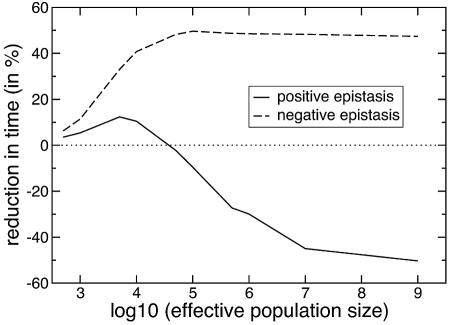FIG. 4.
Reduction in time to fixation of the double mutant through recombination as a function of the effective population size when there is positive or negative epistasis between resistance mutations. Drift effects dominate in populations smaller than 105, and in these populations, recombination reduces the time to fixation. For larger populations, genetic drift is smaller and epistatic interactions determine the population structure. In these populations, recombination only reduces the time to fixation for negative epistasis. For positive epistasis, recombination increases the time to fixation. The following parameters were used: μ = 3 × 10−5,r = 0.5,f = 0.75. The fitness levels of the wild type and double mutant were set to 1 and 1.2, respectively. The fitness levels of both single mutants were 1.05 for positive epistasis and 1.15 for negative epistasis.

